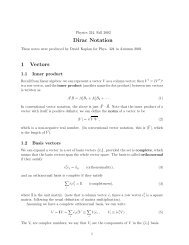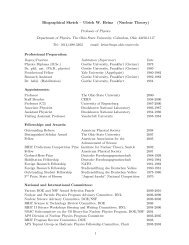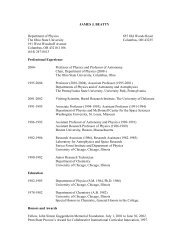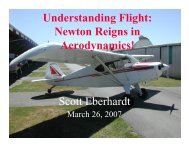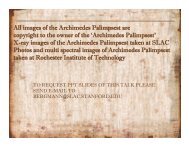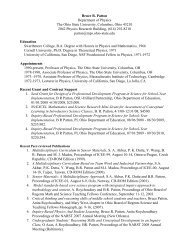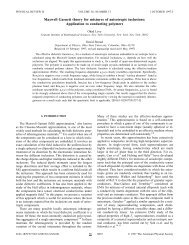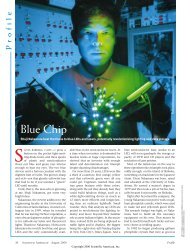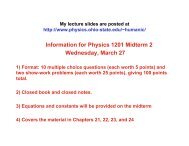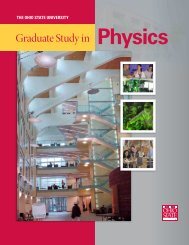Brasil Final Report - Department of Physics - The Ohio State University
Brasil Final Report - Department of Physics - The Ohio State University
Brasil Final Report - Department of Physics - The Ohio State University
You also want an ePaper? Increase the reach of your titles
YUMPU automatically turns print PDFs into web optimized ePapers that Google loves.
15<br />
We do not have the results yet. I will describe the group who is expected to take the exam and the<br />
recommendations <strong>of</strong> the Commission.<br />
<strong>The</strong>re are 88 courses in the whole country granting physics degrees, <strong>of</strong> which 24 are Science<br />
Teaching with major in physics (Licenciatura em Ciências com Habilitação em Física); these<br />
courses have very little physics content and are usually <strong>of</strong>fered at small colleges or smaller towns.<br />
Because <strong>of</strong> this, the exam must be able to assess also students with relatively little knowledge <strong>of</strong><br />
physics.<br />
<strong>The</strong> total number <strong>of</strong> students who took the exam was 1529, probably larger than the number<br />
who will actually graduate in 2000. <strong>The</strong> number <strong>of</strong> graduates in these courses in 1998 has been<br />
1059, <strong>of</strong> which 269 were bachelors degrees, 429 teachers (Licenciados em Física) and 361 science<br />
teachers with major in physics. <strong>The</strong> proportion <strong>of</strong> degrees , approximately 3 : 5 : 4 , was probably<br />
similar to this year.<br />
<strong>The</strong> Commission <strong>Report</strong> states the objectives <strong>of</strong> the exam for the physics courses, the<br />
objectives for the graduating students, the desired pr<strong>of</strong>ile and abilities <strong>of</strong> the graduates. It<br />
recommends an exam in two parts:<br />
I - Common to all degrees and worth 80% <strong>of</strong> the total score: 40 multiple choice questions about<br />
basic or introductory physics , such as taught in the first two years <strong>of</strong> most college or university<br />
courses.<br />
II - Specific for either A)Bachelors or B)Teachers (both kinds), each consisting <strong>of</strong> five questions to<br />
be answered in writing in a few lines, worth 20% <strong>of</strong> the final score.<br />
5. Public Image <strong>of</strong> <strong>Physics</strong><br />
To most people physics is difficult, mathematical, abstract, complex, has many formulae and is<br />
not attractive, rather boring. This probably mirrors most teaching. <strong>The</strong> general public does not see<br />
the beauty <strong>of</strong> our beloved subject. How can we show how interesting it is? <strong>The</strong> answer transcends<br />
the classroom and concerns Science Popularization and the media, particularly television, which is<br />
at present by far the most influential media in Brazil. I will now show some short video films<br />
produced for open channel TV by the educational channel in São Paulo, TV Cultura, and Estação<br />
Ciência, a science center at the <strong>University</strong> <strong>of</strong> São Paulo. <strong>The</strong>re are ten one minute clips, each one<br />
about one physics concept, such as: <strong>The</strong>ory <strong>of</strong> Relativity, Black Holes, What are we made <strong>of</strong>?<br />
(Elementarty Particles), Cosmic Rays, How Long is One Minute? <strong>The</strong>y are made for the general<br />
public, including children, and aim at catching the viewers interest. It is surprising how much<br />
information you can transmit in one minute <strong>of</strong> television. <strong>The</strong>se films were made by a pr<strong>of</strong>essional<br />
TV team, directed by Cao Hamburger; scientists only suggested and checked the contents. <strong>The</strong><br />
clips were quite successful and received several national and international prizes, and are an<br />
example <strong>of</strong> the kind <strong>of</strong> thing you can do to awaken interest in physics.<br />
Brazil is one <strong>of</strong> the top countries in the world in football association. However, in science,<br />
and physics in particular, it is quite good, but not outstanding. One <strong>of</strong> the reasons for this<br />
difference in status in Science and in Soccer is that every young boy (in recent times, also girls) in<br />
Brazil plays soccer in his youth and, if he is interested and has talent, he can go on to become a<br />
pr<strong>of</strong>essional player: the best players are selected from practically the whole population. To<br />
become a scientist, on the other hand, the young man or woman must have finished fundamental<br />
and middle school and entered a university before making the career choice, which reduces the<br />
sample to about one percent <strong>of</strong> the age group.




